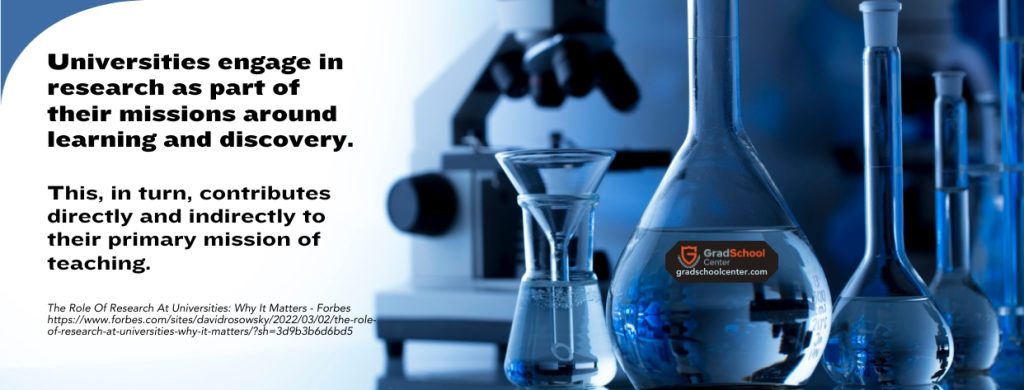20 Graduate Research Centers That Are Making a Real Difference

Find your perfect college degree

Many colleges and universities in the country feature state-of-the-art research centers that positively impact the community around them and even the world at large. Typically organized around the exploration of an issue, project, specific theme, or policy topic, research centers encompass several interdisciplinary works spanning various academic fields.
The establishment of a research center is not a simple process. It often needs to be justified, usually in a way that proves its significance. Research centers are established when there is a strong case that supports its unique academic mission, one that cannot be achieved within the existing structures of the university, namely the departments, schools, and colleges. The dean often authorizes the creation of a research center.
These chartered organizations in the university go beyond facilitating research. It also enables interaction between faculty, scholars, students, and industry in a way that enhances research opportunities and academic excellence. They are often integral in advancing real-world problem-solving and the creation and dissemination of knowledge.
The Benefits of Graduate Research Centers in Universities
The mission of a university often involves research and discovery, along with service and outreach. Research, encompassing the scientific and scholarly aspects, is an important part of many higher learning institutions. Many universities invest resources and state support for research centers. But why is it so important? The following details its many benefits.
Research centers help students develop breadth and depth of knowledge.
Graduate students pursue advanced education in subjects that interest them. Research centers serve as the venue for them to expand their knowledge in foundational and advanced subjects. They get to hone their knowledge acquisition and understanding of particular subjects, including their contextualization, interpretation, and inference. More importantly, it also informs and enhances the knowledge imparted by professors in universities.
Research centers help advance society.
Academic and scientific research advances knowledge and benefits society. Its contributions impact a wide range of industries, from healthcare and education to technology and social policy. Many of the research being championed by centers aim to find solutions to pressing problems and expand one’s understanding of the world.
Research centers strengthen university reputation.
Many universities want to attract the cream of the crop to attract more students and advance their pursuit of knowledge to the benefit of society. Research centers help them do just this by aiding the recruitment and retention of faculty, securing research funding and resources, and promoting continued learning. It plays a significant role in accreditations and the overall competitiveness of the university.
Today’s Top Graduate Research Centers
Center for Artificial Intelligence in Medicine and Imaging (Stanford University)

Stanford’s Center for Artificial Intelligence in Medicine & Imaging was established in 2018 to develop, evaluate, and disseminate artificial intelligence systems that patients can benefit from. Through the use of machine learning and a host of other AI techniques, this Center conducts research that solves clinically important problems surrounding imaging problems. It aims to empower outstanding interdisciplinary artificial intelligence research where clinical data is optimized to promote health.
The center has developed new natural language processing methods that can be used to label imaging studies for machine learning research. Most of their projects have a strong focus on image quality, work optimization, disease classification, automatic report drafting, and early detection. Some of the projects being led by the Center for Artificial Intelligence in Medicine & Imaging include Deep Learning for Computer Vision, Clinical Validation, Image Labeling & NLP, and Fairness and Usefulness.
It is part of the center’s main goals to provide funding opportunities that support research in the field of AI that advances medicine and imaging. The center offers several free educational resources, including Machine Learning, which is in Coursera, AI for Everyone, and Deep Learning Specialization, among others.
Cornell Lab of Ornithology (Cornell University)

Established at Cornell University, the Cornell Lab of Ornithology aims to interpret and conserve the earth’s diversity through research and education with a focus on birds and nature. The research center leads in transforming data into knowledge. It has pioneered new techniques at the interface of citizen science, data visualizations, and machine learning. It offers resources such as interactive courses, curricula, and professional development opportunities that allow students, educators, and bird lovers to explore the fascinating lives of birds.
Through its efforts and initiatives, the center has inspired people of all ages and backgrounds to connect with birds and nature, helping them grow their knowledge and share their observations. It features the Lab on the Ithaca campus, where visitors can enjoy behind-the-scenes tours, guided walks, and exhibits. Those who are interested may also gain access to the Lab through webinars, workshops, and family programs through its virtual home.
The Cornell Lab of Ornithology spearheaded many projects that advance its mission. One of them is the Noise Project, where they build and document processes that promote more equitable scientific research. The center is also home to Project FeederWatch, a three-decade-long dataset about backyard birds. Individuals who want to learn more about birds may want to consider exploring courses that they can take at their own pace. This includes Joy of Birdwatching, Bird Song Basics, Feeder Birds: Identification and Behavior, and the Wonderful World of Owls.
Taub Institute for Research on Alzheimer’s Disease & The Aging Brain (Columbia University)

Taub Institute for Research on Alzheimer’s Disease & the Aging Brain at Columbia University brings together researchers and clinicians who made it their life mission to unearth the causes of Alzheimer’s, Parkinson’s, and other age-related brain diseases. They also seek to discover ways for its prevention and cure. The center’s idea began in the 1980s at the instigation of Drs. Richard Mayeux and Michael Shelanski shared an interest in Alzheimer’s disease. It was in 1995 when the center was officially established through a generous gift from the Taub Family Foundation.
The center operates as an independent department at Columbia University. It promotes and implements projects related to Alzheimer’s, collaborating with other departments and centers in the university and beyond, such as the Department of Medicine, the Department of Psychiatry, the Department of Pathology, the New York State Psychiatric Institute, Human Genetics Resources Core, and Serglevsky Center, among many others.
Part of the research advanced by the center is learning about memory disorders through studying brain tissue. This involves brain autopsy, also known as brain donation. The brain donation program is open to individuals who have been examined by physicians in the center and those who are enrolled in their research projects.
Pritzker Center for Strengthening Children and Families (UCLA)

The Pritzker Center for Strengthening Children and Families at the University of California Los Angeles is dedicated to identifying prevention strategies that can safely reduce the need for foster care. The center was launched in 2018 through the generous gift of the Anthony and Jeanne Pritzker Family Foundation.
The center leads the way in research, aiming to understand and elevate opportunities that meet the needs of children and their families. Their findings help inform policy and practice across various disciplines. Some of the research works under the center include Child Welfare, Public Health, and Domestic Violence; The Impact of COVID-19 on Foster and Relative Caregivers; and Child Welfare & Racial Equity.
The center serves as the site for examining racial dynamics when it comes to foster care. In fact, it proactively and strategically connects the work at UCLA to nonprofit agencies as well as K-12 systems and other education institutions. The center helps develop different resources that support the improvement of foster care, including innovative classroom support systems and family support services.
Koch Institute for Integrative Cancer Research (MIT)

Taking the Massachusetts Institute of Technology approach to solving some of the most difficult problems in cancer, the Koch Institute for Integrative Cancer Research at MIT seeks new ways when it comes to detecting, monitoring, treating, and preventing the disease. The center aims to produce knowledge and tools that apply to a range of cancers, making significant impacts on patients’ quality of life and survival.
The center is a National Cancer Institute-designated institution without any affiliations with specific hospitals or clinics. They collaborate with a wide range of industry partners, ensuring that the innovations and discoveries they make in their laboratories are translated into tools and treatments for cancer. With more than 50 laboratories and over 1,000 researchers, the center is united with key partners in fighting against cancer.
Koch Institute has an impressive reputation in its field, with five current and former faculty members receiving the Nobel Prize award. It is also home to the Robert A. Swanson (1969) Biotechnology Center and 12 other core facilities that provide key technical services to its research community.
Duke Cardiovascular Research Center (Duke University)

A world leader in improving cardiovascular health and curing heart disease, Duke Cardiovascular Research Center is home to prominent scientists who work to improve patient care through discoveries. It also promotes creative integration across translational and clinical enterprises in accomplishing key initiatives such as preventive cardiology, cardiovascular disease treatment, and discovery science.
On top of conducting important research, the pride of Duke University also provides scholarship, training, and mentoring to the next generation of leaders. It has partnerships across various sectors, including caregivers, industry, and innovative thinkers. It is their mission to invest in a future with better tools and medicines to prevent and treat cardiovascular disease.
Recently, the center presented the Victor J. Dzau Lecture series in cardiovascular research, with support from the Mandel Foundation. It features presentations on cardiovascular topics headed by Walter Koch, Ph.D., instructor in the Department of Surgery.
Alzheimer’s Disease Research Center (University of Pittsburgh)

The University of Pittsburgh is home to Alzheimer’s Disease Research Center, one of the country’s leading research centers that specialize in the diagnosis of Alzheimer’s disease and related disorders. It was established in 1985 through a grant from the National Institute on Aging, to integrate, coordinate, and support research in aging and Alzheimer’s disease.
The center has made significant contributions to the scientific study of Alzheimer’s disease through performing and coordinating Alzheimer’s disease-related clinical and research activities. The current research at the center has an emphasis on neuropsychiatry and neuropsychology, basic neuroscience, molecular genetics and epidemiology, and structural and functional imaging.
It has conducted outpatient evaluations, allowing participants and their families to receive state-of-the-art diagnostic assessments. Other services offered at the ADRC include education and counseling for patients and their families and referrals to physicians, adult day care, support groups, and other appropriate programs.
Center for Semiconductor Manufacturing (University of Arizona)

A key player in the advancement of the semiconductor industry, the University of Arizona’s Center for Semiconductor Manufacturing coordinates and facilitates an institutional focus on meeting the needs of various defense and commercial stakeholders. It is also their aim to secure the needed external resources integral to the development of multidisciplinary R&D solutions and training programs responsive to the needs of the semiconductor sector.
It is part of the center’s vision to mobilize the community of faculty and students at the University of Arizona to develop advanced technology solutions and workforce training programs for semiconductor manufacturing, advancing sustainable economic development in the process. One of the center’s facilities includes the Imaging Technology Lab, which is dedicated to advancing scientific and industrial sciences through the development of technologies for the 3D heterogeneous integration of optics, photonics, and semiconductor devices. The center is also home to the Center for Quantum Networks, which leads the development of the entire technology stack to carry quantum data across the globe.
It also houses two micro/nanofabrication facilities found in the College of Engineering and the Wyant College of Optical Sciences. The two facilities serve as workhouses for numerous semiconductor and microelectronics programs.
Center for Sleep and Circadian Biology (Northwestern University)

Northwestern University’s Center for Sleep and Circadian Biology was designed to foster research that illuminates the fundamental mechanisms involving the timing of sleep and circadian rhythms. It also seeks to facilitate the development of treatments that deal with the adverse effects of circadian dysfunctions and determine the consequences of sleep disruption.
The center is home to ground-breaking scientific discoveries. The most prominent of which was the identification of the first mammalian clock gene to be cloned. The center is also instrumental in revealing that the disruption of circadian rhythms can have dramatic repercussions in metabolism, later on, termed as “metabolic syndrome.” It has since remained to be a leader in identifying circadian genes and sleep genes in many model organisms.
The Center for Sleep and Circadian Biology provides administrative support for collaborative research projects. It includes Sleep, Circadian Rhythms & the NIH, and The Core Clock of Mammalian Cells.
Biomedical Imaging Center (University of Texas at Austin)

The University of Texas at Austin houses the Biomedical Imaging Center, which is dedicated to biomedical imaging research. This state-of-the-art center supports human and preclinical imaging research in the university and the wider community. Its facilities span various locations, including the Health Discovery Buildings on the UT campus and the three locations in Norman Hackerman.
The facilities and instruments can be used independently or with assistance. The center also provides in-house training in scanner safety and operations for independent users. Functional MRI studies are supported by the facility on numerous tasks and response paradigms, including audio, visual, and fluid delivery. It also provides support for data archiving, common analyses, and management.
Some of the state-of-the-art tools and instruments within the center include human imaging scanners, preclinical imaging scanners, and other peripheral equipment and accessories.
Genomics Center (University of Minnesota)

The Genomics Center, established at the University of Minnesota, offers genomic technologies and services to researchers and clinicians at the institution and industry scientists throughout the country and the world at large. It is part of its mission to advance the use of genomics and achieve this through acquiring state-of-the-art instruments and offering a myriad of complete services.
Some of the services provided by the center include epigenomics, DNA and RNA Extraction, Single-Cell Genomics, NGS Library Creation, Third-Generation Sequencing, Next-Generation Sequencing, Gene Expression, and Quality Control. The center leads the way in assessing and acquiring emerging technologies to drive life science research and supporting the clinical translation of genomics at the University of Minnesota Health, among many others.
The center is home to Innovation Lab, a research group that primarily focuses on the development of novel tools and technologies for genomics research. The areas of focus for their research work include the development of synthetic standards for NGS applications, improving microbiome measurements, and tool development for functional genomics.
Byrd Polar & Climate Research Center (Ohio State University)

Ohio State University houses the Byrd Polar and Climate Research Center. Its focus is on maintaining research excellence and providing support to public engagement when it comes to polar and climate studies. The center makes its home at Scott Hall, sharing the space with several research groups and their laboratories.
It is the mission of the center to advance world-leading research, education, and outreach that enhances the programs of the university, including cryospheric processes, polar and alpine regions, climate variability, climate change, and the effects of climate on the environment and society. This is being achieved through fostering a collaborative and inclusive community of investigators with specialized facilities, expert project support, and synergistic programs.
Some of the expert project support provided by the center include an extensive library and archives of polar science and exploration, public outreach and communications, and information technology and systems management, among others.
Cochlear Center for Hearing & Public Health (Johns Hopkins University)

As a leader in public health and policy solutions for hearing and aging, Johns Hopkins University’s Cochlear Center for Hearing and Public Health is the only global research institution with a sole focus on issues related to hearing loss as well as public health in older adults. The center pursues the understanding of the impacts of hearing loss, focusing on five core areas that include public awareness, population health evidence, healthcare delivery, policy and legislation, and technology.
The center seeks to optimize the health and function of an aging society, eventually becoming the premier resource for ground-breaking research on hearing loss. Studying the impact of hearing loss on public health, the Cochlear Center recruits and trains researchers, clinicians, and public health experts. The aim is to address hearing loss and help implement effective policies across the local, national, and global scales.
Launched in 2018, the Cochlear Center received more than $20 million in existing grant funding from the National Institutes of Health.
Some of the research focus areas that the center champions include Cognition and Brain Aging, Epidemiology of Hearing Loss, Health Services and Economics, and Hearing Care and Delivery.
Vanderbilt Kennedy Center (Vanderbilt University)

The Vanderbilt Kennedy Center at Vanderbilt University is a research institute and treatment center for autism spectrum disorders. It seeks to improve assessment and treatment services for individuals with ASD and their families. It is also part of its mission to advance knowledge and training in the field.
Some of the key services being offered by the center include diagnostic assessment, parent workshops, and a host of other services to families with children who have or are suspected to have an autism spectrum disorder. The center also provides educators and service providers with necessary training and consultation in behavioral and educational assessment and intervention strategies. This offer is extended to school personnel, pediatric care providers, and community professionals.
The center was established in 1998 to meet the needs of the community for outreach and intervention. Research programs at TRIAD include the diagnosis of autism, early intervention, identification of the features of autism, and ensuring the health and well-being of parents of children with autism.
Center for Coffee Research and Education (Texas A&M University)

Texas A&M University’s Center for Coffee Research and Education is dedicated to improving the quality and supply of coffee and producer livelihoods. It made its home within the Norman Borlaug Institute for International Agriculture at the university.
The center was established as a response to the rapidly growing specialty coffee industry, providing training and education for the next generation of coffee agronomists, business leaders, researchers, and connoisseurs. One of the research studies it has conducted is the Origin and Environmental Conditions for Arabica Coffee. This explores the origins of Arabica coffee.
Through research and training, the center seeks to elevate the lives of smallholder coffee farmers in Central and South America and Rwanda. These international initiatives are constantly developed to meet the changing needs of coffee farmers, including the increased marketing and sales of quality coffee and the expanded capacity at all links in the value chain.
Leonard Davis Institute of Health Economics (Penn)

Advances multidisciplinary research, the Leonard Davis Institute of Health Economics engages the expertise of Penn schools, the Penn Health System, and the Children’s Hospital of Philadelphia.
Founded in 1967, this institute is a gift from Leonard and Sophie Davis, created to fill fundamental gaps in the evidence base that inform policies that are critical to the financing and management of the increasingly costly and complex healthcare system in the country. It is focused on improving health and healthcare by leading the way to collaborative and multidisciplinary research.
The center is home to at least 300 senior fellows from across Penn whose work fits around the six focus areas that the center advances. It includes health equity, healthcare access and coverage, population health, and the opioid epidemic, among others.
Yale Cancer Center (Yale University)

Yale University established the Yale Cancer Center, which the National Cancer Institute is a comprehensive cancer center. Now in its 45th year, the Center is at the forefront of innovative cancer treatment and high-quality patient care. It is a collaboration of the expertise of scientists and physicians at the Smilow Cancer Hospital and the Yale School of Medicine.
The center helped develop 13 multidisciplinary clinical centers to care for patients diagnosed with cancer. The 13 centers provide patient-centered care, rapid access to appointments and relevant tests, and communication or assistance from a dedicated intake specialist and nurse coordinator, among others.
As only one of the 56 comprehensive cancer centers in the country, Yale Cancer Center is known for its research on the mechanisms of cancer biology and the development of innovative and effective therapies for cancer treatment.
Adaptive Intelligent Materials & Systems Center (AIMS – Arizona State University)

Arizona State University features the Adaptive Intelligent Materials & Systems Center (AIMS). It was established to develop a unified theoretical foundation for integrated intelligence systems across multidisciplinary research areas. It also aims to become a national Center of Excellence in the field of intelligent materials and adaptive systems.
The center is striving to integrate a variety of multidisciplinary areas, encompassing electrical, mechanical, material, and computational engineering. It also seeks to develop a solid foundation in the integrated intelligent system design area. The research conducted in the center aims to provide solutions to large-scale problems that directly benefit the economy and society while leaving a significant impact on aerospace and mechanical systems infrastructures.
The research areas in the center include composite metallic & superalloy materials, multiscale modeling from nano to structural scale, and system health management and prognosis.
Blood Research Center (University of North Carolina Chapel Hill)

The University of North Carolina Chapel Hill is home to the Blood Research Center with the mission of promoting interdisciplinary research in non-malignant blood disorders across the university. It seeks to leverage the outstanding international reputation of UNC to recruit and retain world-class scientists in blood research.
The center also aims to develop new programs in blood research that complement existing strengths and meet the evolving needs for hematologic expertise. It leads clinical trials that seek to support the advancement of medical knowledge when it comes to bleeding and clotting disorders through supporting research in these areas.
Some of the research works being pursued at the center include focus areas on thrombosis, bleeding disorders, and sickle cell disease.
Center for Astrophysics (Harvard University)

A collaboration between Harvard and the Smithsonian, the Center for Astrophysics is designed to both ask and answer some of the unresolved questions of humanity when it comes to the nature of the universe. It was founded in 1973 to foster innovation and propel discovery.
The center’s mission is to advance knowledge of the universe with the use of research that focuses on astronomy and astrophysics. It houses more than 850 researchers, scientists, and support staff. Many of the scientists, engineers, fellows, and graduate students who collaborate with the center are accomplished leaders and experts in their fields. This enables the cultivation of an atmosphere of excellence.
The collaboration between Harvard and the Smithsonian seeks to coordinate the related research activities between the Harvard College Observatory and the Smithsonian Astrophysical Observatory.

Key Takeaways
- While not considered an academic department, a research center is vital in advancing research training, dissemination, and innovation in many universities. They are not only an important part of the academic setting at the university but also vital in forming and enriching its cultural setting.
- Research centers are instrumental in advancing knowledge and leading the way to innovation. Many of them seek to answer important questions and address some of the world’s pressing problems. Some focus on finding cures for diseases and others aim to positively impact the society at large with its various research initiatives, programs, training, and other resources.
- This list of research centers features some of the best in the country, illustrating the rich research culture that moves the world forward.




